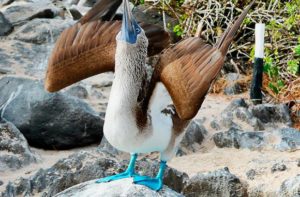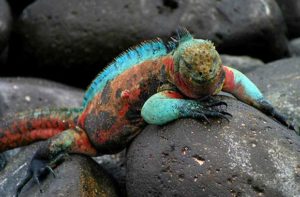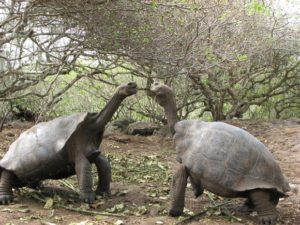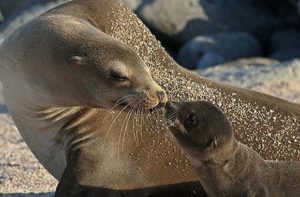 famous bird of the Galapagos Islands
famous bird of the Galapagos IslandsThe blue-footed booby is a sea bird. It is, as indicated in its name, distinguished by its blue feet. This species lives mainly on the west coast of the American continent (from California to Peru, passing of course through the Galapagos Islands). These birds, known for the color of their legs, are also known for their unique courtship ritual: the male shows his blue feet to his partner by walking slowly and lifting his flippers high. He then holds his beak up to the sky while opening his wings.

The Galapagos Islands are inhabited by terrestrial and marine Iguanas. The terrestrial iguanas feed mainly on plants and insects while those that are marine eat red and green algae. These reptiles can measure between 75cm and 1m long and weigh up to 13kg! Moreover, the different species can be distinguished by the different colors of their scales. The marine iguana is emblematic of the Galapagos Islands as it is the only one of its group to have a semi-aquatic lifestyle.

You may not believe it, but the giant tortoises of the Galapagos Islands are descended from the smaller and lighter turtles located on the South American continent. Indeed, they have adapted to their new environment, which is why today they can measure more than 1.5m and weigh more than 250kg! Different turtles are present in the archipelago:
the saddle-shell turtle that has longer legs and a bigger neck to feed on plants in heights.
the one with a domed shell, which allows it to resist temperature changes to live on islands with relief.
The narrow-shelled turtle, which allows it to move more easily in dense vegetation.

This species is the smallest of the sea lion family. The females measure about 1.2m and weigh 30kg as an adult, while males are about 1.6m tall and can weigh up to 70kg! These animals from the Galapagos Islands feed on octopus, cuttlefish but also on sardines. Do you know why the sea lion has big eyes? It is because it is a nocturnal species that hunts at night and can stay underwater for about 7 minutes! Beware however, the fur seal is an endangered animal. This is why it is important to respect their habitat and to limit climate change as much as possible.
WhatsApp us